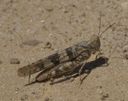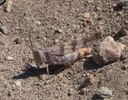Trimerotropis
Trimerotropis
Classification
- Phylum: Arthropoda
- Subphylum: Hexapoda
- Class: Insecta
- Order: Orthoptera
- Suborder: Caelifera
- Family: Acrididae
- Subfamily: Oedipodinae
- Tribe: Trimerotropini
- Genus: Trimerotropis
Pronunciation
How to pronounce Trimerotropis: /traɪmɛroʊˈtroʊpɪs/
These audio files are automatically generated. While they are not always 100% accurate, they are a good starting point.
Images






Summary
Trimerotropis is a genus of band-winged grasshoppers, with species prevalent in North America. They are characterized by their slender bodies, distinctive wing markings, and ability to produce unique sounds when flying. The genus is likely to undergo redefinition as more is learned about species relationships.
Physical Characteristics
Mostly relatively slender, medium-sized (about 1 to 2 inches long). Pronotal ridge is cut twice, usually faint or absent on the posterior half. Front wings have dark markings, with dark cross bands or irregular dark spots. Hind wings have yellow, green, or blue coloration (never reddish) with a dark cross band and a spur. Hind femora usually show faint diagonal crossbands externally. Hind tibia can vary in color, including brown, blue, green, yellow, orange, red, or rarely purplish.
Identification Tips
Identify by comparing hind tibia color and wing markings. The presence of dark cross bands and the coloration of hind wings are critical for species identification. Crepitation sounds produced during flight can also assist in identification.
Habitat
Found in open sunny areas, typically in environments with bare ground or exposed rocks.
Distribution
Coast to coast across North America, primarily south of Boreal forests, with a majority located in western regions.
Diet
Herbivorous, feeding on various grasses and herbaceous plants.
Life Cycle
Not specified in the provided data.
Reproduction
Not specified in the provided data.
Predators
Not specified in the provided data.
Conservation Status
Not specified in the provided data.
Ecosystem Role
Acts as both herbivore and prey within its ecosystem.
Economic Impact
Not specified in the provided data.
Cultural Significance
The common name 'cracker grasshopper' arises from the distinct sound it produces in flight, which may hold significance in local culture or study.
Health Concerns
Not specified in the provided data.
Evolution
Species are grouped based on chromosome structures, with two major divisions identified (Section A and Section B) based on different chromosome numbers.
Similar Taxa
Misconceptions
Historically, there has been confusion between various species of Trimerotropis and Spharagemon, especially with red hind tibiae, leading to misidentified specimens.
Tags
- grasshopper
- orthoptera
- Acrididae
- Trimerotropis
- band-winged
- North America